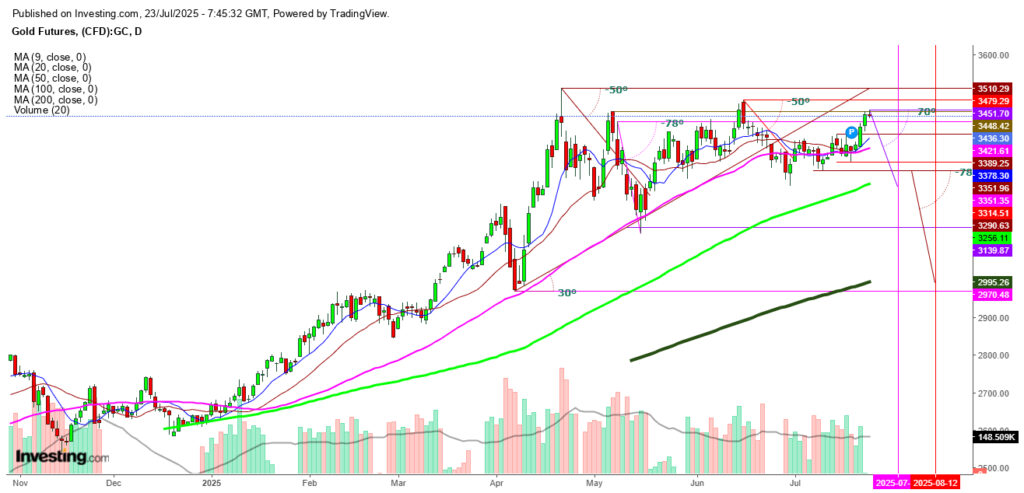In the constantly shifting landscape of global trade and financial markets, recent developments have brought to light significant movements in commodity futures, particularly gold, and the strength of the US dollar against a basket of major currencies. This analysis seeks to delve into these trends, offering a comprehensive outlook based on recent events, including a notable trade agreement between the United States and Japan, and its broader implications for investors and the global economy. This discussion aims to unravel the complexities behind these movements, providing clarity and insight to those following the intricate dynamics of international trade and finance.
The evolution of gold futures and the US dollar’s value is a story interlinked with geopolitical developments and economic policies. Since the beginning of April, when US President Donald Trump announced comprehensive tariffs on various trading partners, financial markets have been in a state of flux. These tariffs, which threatened to upend decades-old trade frameworks, initially led to widespread concern and uncertainty across global financial markets. Specifically, the announcement had a pronounced impact on the US dollar, causing it to weaken against other major currencies as investors anticipated potential retaliatory measures and disruptions in international trade.
However, a turning point seemed to emerge with President Trump’s recent announcement of a trade agreement with Japan. Under this new deal, Japan would be subjected to a 15% tariff rate, significantly lower than the originally proposed 25%. This development has ignited optimism that similar agreements could be forthcoming, especially with an impending tariff deadline that could affect multiple facets of global trade. Such optimism is critical as it suggests a potential smoothing of U.S. trade relations with other economic powers, possibly mitigating the broader impacts of the initial tariff announcements.
The immediate consequence of this development appears to be a bolstering of the US dollar. After a period of decline following the initial tariff announcement, the currency has shown signs of recovery. This rebound is evidenced by the performance of the US Dollar Index, which tracks the dollar against a basket of other major currencies. After a three-day decline, the index rose to 97.225, indicating a resurgence in the strength of the dollar. This resurgence is especially notable given the dollar’s position near its lowest level since July 10th, prior to recovering.
On the commodities front, gold futures have displayed significant volatility. A bearish doji pattern emerged in a recent trading session, following a three-day surge that encountered substantial resistance. This pattern suggests that the short-term trajectory for gold futures could be downwards, especially as they face immediate support levels at $3421 and $3388. Should gold break below these levels, it could signify an escalation in bearish pressure on the precious metal.
Conversely, any attempt by gold to surpass the immediate resistance level at $3457 could potentially attract significant selling pressure, especially in light of the dollar’s anticipated strength. This intricate dance between gold futures and the US dollar is emblematic of the broader economic and geopolitical dynamics at play.
Furthermore, the announcement by Trump not only underscores progress made toward reaching trade deals before the significant August 1 deadline but also brings to the fore the persistent spectre of tariffs as a key factor of uncertainty. Despite the recent US-Japan deal indicating a possible softening in the US stance towards its trading partners, it’s crucial to recognize that such agreements are but one piece of a much larger puzzle.
Looking ahead, gold futures and the broader financial markets are likely to remain sensitive to developments in US trade policy, particularly negotiations with the European Union, which had been preparing retaliatory tariffs in response to US demands. The outcome of these negotiations could significantly influence market sentiment and the direction of both the US dollar and gold prices.
In conclusion, while the US-Japan trade agreement presents a glimmer of hope for more amicable US trade relations worldwide, the road ahead remains fraught with uncertainty. The potential for further volatility in gold futures and the US dollar index persists, influenced by negotiations with the European Union and other trade partners. As the August 1 deadline approaches, markets will likely continue to react to any signs of progress or setbacks in these negotiations. Nonetheless, the overhanging cloud of tariffs and their impact on international trade relations, inflation, and economic growth cannot be ignored. Such factors will undoubtedly play a crucial role in shaping investor sentiment and the performance of key financial instruments in the months ahead.
It’s imperative for readers to note that any positions taken in gold, USD Index futures, and USD/Yen based on this analysis should be made with caution, as these observations are derived from current market conditions and geopolitical developments. The financial landscape is inherently dynamic, and as such, strategies should be adapted to respond to unfolding events and trends.


